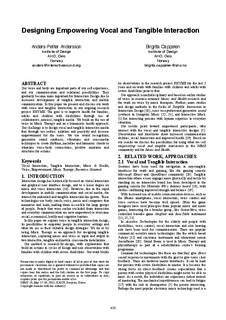Designing Empowering Vocal and Tangible Interaction
Chapter
Permanent lenke
http://hdl.handle.net/11250/93011Utgivelsesdato
2013Metadata
Vis full innførselSamlinger
Originalversjon
Yeo, Woon Seung; Lee, Kyogu; Sigman, Alexander; Ji, Haru; Graham, Wakefield [Eds.] Proceedings of the International Conference on New Interfaces For Musical Expression p. 406-412 Proceedings of the International Conference on New Interfaces for Musical Expression, Korea Advance Institute of Science and Technology, 2013Sammendrag
Our voice and body are important parts of our self-experience, and our communication and relational possibilities. They gradually become more im
portant for Interaction Design due to increased development of tangible interaction and mobile communication. In this paper we present and discuss our work with voice and tangible interaction in our ongoing research project RHYME. The goal is to improve health for families, adults and children with disabilities through use of collaborative, musical, tangible media. We build on the use of voice in Music Therapy and on a humanistic health approach. Our challenge is to design vocal and tangible interactive media that through use reduce isolation and passivity and increase
empowerment for the users. We use sound recognition, generative sound synthesis, vibrations and cross-
media techniques to create rhythms, melodies and harmonic chords to stimulate voice-
body connections, positive emotions and structures for actions.
